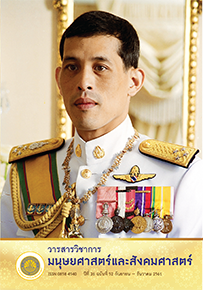Communicative Patterns and Identity Perception amongst Mon Migrants in Samutsakhon Province
Main Article Content
Abstract
This paper presents some of the results from a qualitative study entitled Communicative Patterns and Identity Perception amongst Mon Migrants in Samutsakhon Province. This study aimed to explore 1) how Mon migrants came to live and work in Samutsakhon Province and 2) what the communicative patterns amongst them were. Data were collected by informal talk, in-depth interviews and focus group. The results showed that historically, Mon migrants came to Thailand to escape from wars and to avoid famine, and because they were needed for employment as laborers. The main reasons for immigration were escaping from wars and the need for employment. The study found two communicative patterns: internal and external communications. As far as the internal communication of the group of Mon migrants was concerned, they used social media such as facebook, events such as the national day and Buddhist lent day to interact with each other. For external communication and interaction with Thai people, they used Thai for everyday life and to talked to their employers hierarchically. This research on the identity perceptions have revealed 3 key points: 1.) Mon migrants has been helpers in terms of labour, not second-class citizens. 2.) Mon is not Burmese, and the Burmese are others. and 3.) Betel chewing has been an important part of Mon’s tradition.
Downloads
Article Details
บทความทุกบทความเป็นลิขสิทธิ์ของวารสารวิชาการมนุษยศาสตร์และสังคมศาสตร์ มหาวิทยาลัยบูรพาเท่านั้น
References
https://www.doe.go.th/alien กกจ.3/2561.
กาญจนา แก้วเทพ และคณะ. (2543). สื่อเพื่อชุมชน การประมวลองค์ความรู้. กรุงเทพฯ: สำนักงานกองทุนสนับสนุนการวิจัย (สกว.).
ฉวีวรรณ ประจวบเหมาะ. (2547). ทบทวนแนวทางการศึกษาชาติพันธุ์ข้ามยุคสมัยกับการศึกษาในสังคมไทย. ใน ว่าด้วยแนวทาง
การศึกษาทางชาติพันธุ์ (หน้า 40-103). กรุงเทพฯ: ศูนย์มานุษยวิทยาสิรินธร (องค์การมหาชน).
เจือจันทร์ วงศ์พลกานันท์. (2549). กระบวนการสร้างอัตลักษณ์ของสตรีชายแดนกลุ่มชาติพันธุ์มอญและปฏิสัมพันธ์กับกลุ่มพม่าและ
ไทย: กรณีศึกษาชุมชนมอญในจังหวัดกาญจนบุรี. วิทยานิพนธ์ปริญญาดุษฎีบัณฑิต, สาขาสหวิทยาการ, วิทยาลัยสหวิทยาการ, มหาวิทยาลัยธรรมศาสตร์.
ชาญวิทย์ เกษตรศิริ. (2533). พม่า: ขบวนการนักศึกษากับประวัติศาสตร์ระทึกใจ. กรุงเทพฯ: ประพันธ์สาสน์.
เชิญขวัญ ภุชงค์. (2549). การสื่อสารของกลุ่มซาไกที่ย้ายถิ่นฐานมาสู่ชุมชนเมืองในการปรับตัวและแสดงอัตลักษณ์แห่งชาติพันธุ์.
วิทยานิพนธ์นิเทศศาสตรมหาบัณฑิต, สาขาวิชานิเทศศาสตรพัฒนาการ, คณะนิเทศศาสตร์, จุฬาลงกรณ์มหาวิทยาลัย.
ณฐพงศ์ จิตรนิรัตน์. (2553). อัตลักษณ์ชุมชน: อัตลักษณ์และการเปลี่ยนแปลงตำแหน่งแห่งที่ของชุมชน. สงขลา: นำศิลป์โฆษณา.
สมสุข หินวิมาน.(2548). ประมวลสาระชุดวิชาปรัชญานิเทศศาสตร์และทฤษฎีการสื่อสารหน่วยที่ 8-15 นนทบุรี: มหาวิทยาลัยสุโขทัยธรรมาธิราช.
สุกัญญา เบาเนิด.(2549). การสร้างอัตลักษณ์ของคนมอญย้ายถิ่น: กรณีศึกษาแรงงานข้ามชาติในจังหวัดสมุทรสาคร. วิทยานิพนธ์
มานุษยวิทยามหาบัณฑิต, สาขาวิชามานุษยวิทยา, ภาควิชาสังคมวิทยาและมานุษยวิทยา, คณะรัฐศาสตร์, จุฬาลงกรณ์มหาวิทยาลัย.
สุจิตรา เปลี่ยนรุ่ง. (2553). การสื่อสารเพื่อสร้าง ธำรงรักษา และต่อรองอัตลักษณ์ความเป็นมอญของกลุ่มชาวมอญพลัดถิ่นในประเทศไทยท่ามกลางกระแสโลกาภิวัตน์. วิทยานิพนธ์นิเทศศาสตรดุษฎีบัณฑิต, สาขาวิชานิเทศศาสตร์, คณะนิเทศศาสตร์,
จุฬาลงกรณ์มหาวิทยาลัย.
สุภรณ์ โอเจริญ. (2541). มอญในเมืองไทย. กรุงเทพฯ: มหาวิทยาลัยธรรมศาสตร์.
องค์ บรรจุน. (2549). บ้านทุ่งเข็น: ชุมชนชาติพันธ์มอญร่วมสมัยแห่งสุพรรณบุรี. วิทยานิพนธ์ปรัชญาดุษฎีบัณฑิต, สาขาวิชา สหวิทยาการ, วิทยาลัยสหวิทยาการ, มหาวิทยาลัยธรรมศาสตร์.
Lewis, G. and Slade, C. (2000). Critical Communication. Upper Saddle River, New Jersey: Printice Hall.


